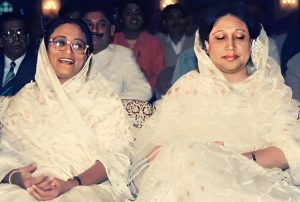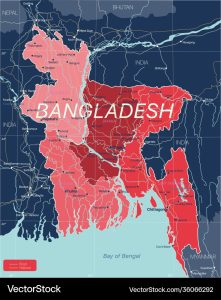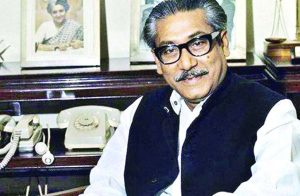Well, the truth is, I don’t know much. I know it was East Pakistan for a while, and then turned into an independent country in 1971, after a viscous war. A poor country for a long time, annually affected by massive floodings in the delta of the combined Ganges and Brahmaputra, which takes quite a lot of water from the Himalayas and the Indian subcontinent to the Gulf of Bengal. The world’s preeminent garment production centre, where young women and children are being slaved around in unsafe factories until these burn down, with horrific results: the price we pay for our cheap fashion – well, the price we don’t pay ourselves, actually, that’s why it is so cheap. Also the country that accepted well over a million Rohingya refugees fleeing genocide from Myanmar since 2017, for which it should be commended. Ruled for the last centuries by the two begums, wife/daughter of earlier dictators who increasingly adopted the policies of their husband/father, until one, Sheik Hasina, prevailed, using time-honoured techniques like putting all your opponents in jail. Until she herself had to flee the country, under pressure from demonstrating students. After which Mohamed Yunus, inventor of micro-credit and Nobel peace prize winner, was appointed interim-president in 2024.
Not surprisingly, there is more to Bangladeshi history than this. Before East Pakistan, before Bangladesh, it is the history of India, where Arab traders brought Islam in the 9th Century, culminating in the Mughal dynasties of the 16th to 18th C. And a lot more, of course, here less relevant. And then the Brits came: after an early foothold in Surat, on the West Coast of India, they established their base in Calcutta in 1690, in Bengal, which was then one of the wealthiest regions in India.
The first signs of a split up came in 1905, when viceroy George Curzon created two new provinces: Western Bengal, including Bihar and Orissa; and Eastern Bengal and Assam. With its capital at Calcutta, Western Bengal had a Hindu majority, while the province of Eastern Bengal and Assam, with its capital at Dhaka, was predominantly Muslim. Six years later, Curzon thought the better of it, and merged the two again, under pressure from Hindu forces in West Bengal, even though the Muslims in East Bengal supported the split-up.
By 1947, with the departure of the Brits, the India as it was violently split into two parts, Hindu-dominated India and Muslim-dominated Pakistan; partition was extended to Bengal, too, and East Bengal became part of Pakistan. With the only common denominator a religion, two vastly differing cultures, thousands of kilometres away.
(enter ChatGPT) From the outset, East Pakistan was politically and economically marginalized. Despite being home to the majority of Pakistan’s population, East Pakistan was underrepresented in national politics, and its economy was largely controlled by West Pakistan. One of the first major issues arose over language. In 1948, the central government of Pakistan declared Urdu the sole national language, ignoring Bengali, the language spoken by the majority in East Pakistan. This led to widespread protests, culminating in the Language Movement of 1952, during which several students were killed by police while protesting in Dhaka.
Over the following decades, East Pakistanis grew increasingly resentful of the political and economic domination of West Pakistan. The Awami League, a political party led by Sheikh Mujibur Rahman, emerged in the 1960s as the voice of East Pakistani autonomy.
Tensions came to a head after the 1970 general elections, in which the Awami League won an overwhelming majority of seats in the national assembly, based largely on its support in East Pakistan. Despite the League’s victory, the central government, dominated by West Pakistan, was unwilling to transfer power to the Awami League. This led to mass protests in East Pakistan and demands for independence.
In March 1971, after months of political deadlock, the Pakistani military launched a brutal crackdown in Dhaka, targeting students, intellectuals, and political activists. The military operation, known as Operation Searchlight, led to widespread atrocities, including mass killings and rape. Millions of Bengalis fled to neighbouring India, sparking a refugee crisis.
On March 26, 1971, followers of the by then arrested Sheikh Mujibur Rahman declared Bangladesh’s independence. A nine-month war ensued, with the Mukti Bahini (Bengali guerrilla forces) fighting against the Pakistani military. India, which had been hosting millions of refugees, eventually intervened in December 1971, leading to the surrender of Pakistani forces and the creation of an independent Bangladesh on December 16, 1971. (exit ChatGPT)
Post-independence, Sheikh Mujibur Rahman became the country’s first prime minister, but his government faced significant challenges, including famine, corruption, and political instability. And he became increasingly autocratic. In 1975, he was assassinated in a military coup, the first of many, which brought General Ziaur Rahman (often called Zia) to power, only to be assassinated himself in 1981. In 1982, another general, Hussain Muhammad Ershad, surfaced as dictator, but was forced out by protest in 1990.

A rare 1990 photograph showing the two Bangladesh Begums, Sheikh Hasina and Khalida Zia, together, before their political polarization took off
Which, amazingly, led to something close to democratic rule, dominated by the two Begums referred to earlier: Sheikh Hasina, the daughter of Sheikh Mujibur Rahman and leader of the secular Awami League, and Begum Khaleda Zia, the widow of Ziaur Rahman and leader of the more conservative BNP. Their political battle led to intense political polarization, lots of general strikes, violent protests, and widespread instability. For a while they swapped the position of prime minister every 5 years, not hindered by accusations of corruption on both sides, and occasionally forced out by mass protests about incompetence and corruption. In the end, since 2009, Sheik Hasina proved the more astute, marginalising her competitor politically, and finally locking her, and many more opposition leaders, up, to remain in power until 2024.
When she was, in line with Bangladeshi tradition, finally forced out of power not by elections but by widespread student protests, and left last August. After which Mohamed Yunus was appointed interim-president, with the task to bring democracy back to Bangladesh after years of autocratic rule. Hmm, bringing democracy back is rather over-estimating Bangladeshi history since independence, but if anybody has credibility in this land of challenges, it is Mr Yunus.
next, about Bangladesh’s development












